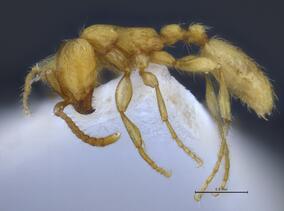You are here
Formicidae
Aenictus Shuckard, 1840
Nomenclature
-
Subfamily: Dorylinae
SUMMARY
From Shuckard, (1840) [1]
Body elongate cylindrical.
Head small, transverse, flat.
Antenna short, setaceous, curved, inserted upon the anterior margin of the clypeus, and notquite so long as the insertion of the superior wings, the scape about one-third the length of theflagelium, the joints of the latter equal.
Eyes globose, lateral, and very prominent.
Ocelli placed in a slight curve upon the vertex, large and very prominent.
Mandibles edentate, elongate, slender, compressed, very much curved, slightly broader at the base, and forcipate.
Labrum truncated at the apex, where it is emarginate in the centre.
Maxillae , Maxillary palpi ,Labial palpi :The internal trophi I am obliged to pass over, but as they are scarcely distinguishable in the large species of Dorylus in a small insect like the present, which is at least fifty times less, the investigation would incur a certainty of destruction without possibly effecting the object; but it is quite sufficiently distinguished by its more obvious characters.
Thorax short, oval : collar or proihorax more developed than in Dorylus, and not concealed in front by the gibbosity of the mesothorax : scutellum quadrate, very gibbous, slightly projecting over the metathorax, which is perpendicular.
Tegulae: small but distinct.
Superior wings with a large stigma, one acuminated, marginal cell angulated and two submarginal cells, the first of is smaller within, than the second, and receives the recurrent nervure at nearly three- fourths of its length.
Legs short and slender: coxae robust, canaliculated above for the articulation of the femur: trockanter not distinct: femora and tibice slender and subcylindrical, the latter furnished at their apex with a single calcar: tarsi slender, longer than the tibiae, the basal joint as long as the three following, the fourth joint the shortest: the claws simple.
Abdomen elongate, curved downwards, cylindrical and slightly clavate; the dorsal segments, but especially the terminal ones, slightly constricted; the penultimate segment much shorter than the antepenultimate, and forming merely a transverse slip; the first segment, which forms the peduncle, quadrate, the angles rounded; above deeply channeled down the middle, which gives it a bilobate appearance, beneath earinated and flattened laterally from this carina: the apical segment obtuse and rounded.
References
- W. Edward Shuckard, “Monograph of the Dorylidae, a family of the Hymenoptera Heterogyna. (Continued from p. 201.).”, Annals of Natural History, vol. 5, pp. 258-271, 1840.






